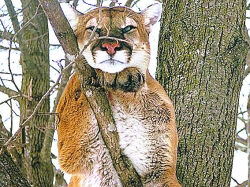
April 22, 2009


Above: The cougar confirmed in Wisconsin, March 2009.
Editiorial comment on the following article: Often forthcoming official national policy changes in the United States are hinted and forecast by general overview articles like this one. It is as if a bit of leaking of how a broader move in a point of view slowly is exposed through an insightful media.
While the existence of cougars, pumas, or mountain lions is a foregone conclusion to the thousands of people in the Midwest who have seen them, an article such as this often signals the coming realignment of old and outdated stances at the governmental level, as well as at the policy and procedural ones.
Read this complete article carefully, for I think it foreshadows a broader shift in the future approach and acceptance of these large felids in central and eastern North America. – Loren Coleman
Anna Lashley can’t forget the surprise when she looked out her kitchen window three years ago just south of Milwaukee and spotted what she believes was a cougar.
“I looked up and there’s this lion in the back yard, and I thought it must have gotten away from the zoo,” she said. “I called the zoo, and they said they hadn’t lost one.”
Since then, she’s seen several cougars, most recently in March. She’s not alone. The animals were wiped out in most of the eastern U.S. a century ago but have recently shown up again, migrating from the Black Hills of South Dakota into places like Minnesota, Iowa, Illinois and Wisconsin.
A cougar was shot and killed by police in Bossier City, La., in December 2008.


In April 2008 Chicago police shot and killed a 122-pound cougar (shown in the two photos above) in the city’s North Side. And in 2007, the first documented cougar in Kansas in more than 100 years was killed near Medicine Lodge.
Aside from a small population in south Florida, central Texas is the eastern boundary of the cougar’s customary breeding range.
But now Wisconsin game managers get scores of reported sightings each year. They try to determine which are false, which are other animals, such as bobcats, and which are cougars.
Only two cougars have been confirmed in the state. The cougar killed in Chicago was seen and left clear tracks in the snow months earlier in the Milton area of Rock County in January 2008. Bear hunters chased the second into a tree near Spooner in Barron County in March. It was photographed before an attempt to tranquilize it and attach a tracking collar failed and it fled.
Ken Jonas, a wildlife biologist supervisor with the state Department of Natural Resources in Hayward, said the only way to confirm sightings was with photos, good tracks or other physical evidence. In the case of the confirmed sightings, blood, hair, urine and droppings were recovered.
Researchers learned a lot from the cat that roamed the Milton area for three months before being shot, said Eric Anderson, a professor of wildlife ecology at the University of Wisconsin-Stevens Point.
“Here’s a cat wandering across the landscape of southern Wisconsin and northern Illinois, a fairly heavily populated area, and nobody saw it,” he said.
Male cougars like that have been moving out from the Black Hills. Anderson said an estimated 20 to 25 young males are believed to leave there each year and go looking for females, as well as food.
He expects Wisconsin will eventually have resident cougars.
But if the state had a breeding population now, some cougars would be killed on roads and found feeding on livestock and more evidence would be found in areas where the animals spent time, Jonas said.
Still, he said people venturing outdoors should be aware of potential dangers. He noted the state also has black bears and a healthy wolf population, and even a deer in rut can pose a threat.
The Lashleys said they have nothing against cougars, but they want people to be aware of their presence.
Sandy Kenner said she has no doubts the cats are here.
“I’m totally convinced. I wouldn’t jog at night anymore,” she said. “It doesn’t scare me. Just don’t be stupid.”
Apr 22, 2009. 4:32 AM EDT
Source: Sightings show cougars expanding into central US, by James A. Carlson, Associated Press Writer, from Caledonia, Wisconsin.
***
Here are some safety suggestions for people who encounter cougars:
– Stand your ground, try to look as large as possible and be aggressive, shouting and throwing rocks or sticks at the cat.
– Do NOT turn and try to run.
***
DNR Rare Mammal Observation Form.
Thank You.
About Loren Coleman
Loren Coleman is one of the world’s leading cryptozoologists, some say “the” leading living cryptozoologist. Certainly, he is acknowledged as the current living American researcher and writer who has most popularized cryptozoology in the late 20th and early 21st centuries.
Starting his fieldwork and investigations in 1960, after traveling and trekking extensively in pursuit of cryptozoological mysteries, Coleman began writing to share his experiences in 1969. An honorary member of Ivan T. Sanderson’s Society for the Investigation of the Unexplained in the 1970s, Coleman has been bestowed with similar honorary memberships of the North Idaho College Cryptozoology Club in 1983, and in subsequent years, that of the British Columbia Scientific Cryptozoology Club, CryptoSafari International, and other international organizations. He was also a Life Member and Benefactor of the International Society of Cryptozoology (now-defunct).
Loren Coleman’s daily blog, as a member of the Cryptomundo Team, served as an ongoing avenue of communication for the ever-growing body of cryptozoo news from 2005 through 2013. He returned as an infrequent contributor beginning Halloween week of 2015.
Coleman is the founder in 2003, and current director of the International Cryptozoology Museum in Portland, Maine.
Filed under Alien Big Cats, Breaking News, Cryptotourism, CryptoZoo News, Mystery Cats